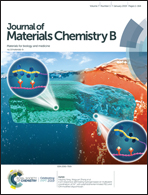Cationized Bombyx mori silk fibroin as a delivery carrier of the VEGF165–Ang-1 coexpression plasmid for dermal tissue regeneration
Abstract
The angiogenesis of an implanted construct is among the most important issues in tissue engineering. In this study, spermine was used to modify Bombyx mori silk fibroin (BSF) to synthesize cationized BSF (CBSF). BSF and CBSF were coated in sequence on the surface of polyethyleneimine (PEI)/vascular endothelial growth factor 165/angiopoietin-1 coexpression plasmid DNA (pDNA) complexes to form CBSF/BSF/PEI/pDNA quaternary complexes. BSF scaffolds loaded with carrier/pDNA complexes were prepared as dermal regeneration scaffolds by freeze-drying. In one set of experiments, scaffolds were used to cover a chick embryo chorioallantoic membrane (CAM) to investigate the influence of carrier/pDNA complexes on angiogenesis; in another set of experiments, scaffolds were implanted into dorsal full-thickness wounds in Sprague-Dawley rats to evaluate the effect of carrier/pDNA complex-loaded BSF scaffolds on neovascularization and dermal tissue regeneration. After modification with spermine, the surface zeta potential value of BSF rose to +11 mV from an initial value of −9 mV, and the isoelectric point of BSF increased from 4.20 to 9.04. The in vitro transfection of human umbilical vein endothelial cells (EA.hy926) with quaternary complexes revealed that the CBSF/BSF/PEI/pDNA complexes clearly exhibited lower cytotoxicity and higher transfection efficiency than the PEI/pDNA complexes. The CAM assay showed a more abundant branching pattern of blood vessels in BSF scaffolds loaded with CBSF/BSF/PEI/pDNA complexes than in BSF scaffolds without complexes or loaded with PEI/pDNA complexes. The in vivo experimental results demonstrated that the incorporation of CBSF/BSF/PEI/pDNA complexes could effectively enhance angiogenesis in the implanted BSF scaffolds, thereby promoting the regeneration of dermal tissue, providing a new scaffold for the regeneration of dermal tissue and other tissues containing blood vessels.



 Please wait while we load your content...
Please wait while we load your content...